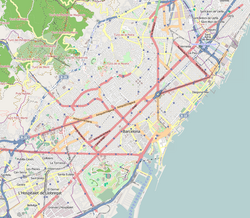Arc de Triomf | ||||||||||||||||||||||||||||||||||||||||
|---|---|---|---|---|---|---|---|---|---|---|---|---|---|---|---|---|---|---|---|---|---|---|---|---|---|---|---|---|---|---|---|---|---|---|---|---|---|---|---|---|
 Rodalies de Catalunya station in 2022 | ||||||||||||||||||||||||||||||||||||||||
| General information | ||||||||||||||||||||||||||||||||||||||||
| Coordinates | 41°23′30.33″N2°10′48.69″E / 41.3917583°N 2.1801917°E | |||||||||||||||||||||||||||||||||||||||
| System | Rodalies de Catalunya and Barcelona Metro interchange complex | |||||||||||||||||||||||||||||||||||||||
| Owned by | ||||||||||||||||||||||||||||||||||||||||
| Operated by |
| |||||||||||||||||||||||||||||||||||||||
| Lines | ||||||||||||||||||||||||||||||||||||||||
| Platforms | 2 side platforms for each station | |||||||||||||||||||||||||||||||||||||||
| Tracks | 2 for each station | |||||||||||||||||||||||||||||||||||||||
| Connections |
| |||||||||||||||||||||||||||||||||||||||
| Construction | ||||||||||||||||||||||||||||||||||||||||
| Structure type | Underground | |||||||||||||||||||||||||||||||||||||||
| Bicycle facilities | Bicing station located nearby | |||||||||||||||||||||||||||||||||||||||
| Accessible | yes | |||||||||||||||||||||||||||||||||||||||
| Other information | ||||||||||||||||||||||||||||||||||||||||
| Station code |
| |||||||||||||||||||||||||||||||||||||||
| Fare zone | 1 (ATM Àrea de Barcelona and Rodalies de Catalunya's Barcelona commuter rail service) | |||||||||||||||||||||||||||||||||||||||
| History | ||||||||||||||||||||||||||||||||||||||||
| Opened |
| |||||||||||||||||||||||||||||||||||||||
| Services | ||||||||||||||||||||||||||||||||||||||||
| ||||||||||||||||||||||||||||||||||||||||
| ||||||||||||||||||||||||||||||||||||||||
Arc de Triomf is a Rodalies de Catalunya and Barcelona Metro interchange complex. It is named after the adjacent triumphal arch of the same name near which it is situated, in the Barcelona district of Eixample in Catalonia, Spain. The Rodalies station is served by Barcelona commuter rail service lines R1, R3 and R4, as well as Girona commuter rail service line RG1 and regional line R12. The Barcelona Metro station is served by TMB-operated line L1.
Contents
The complex is located near Estació del Nord, Barcelona's main bus station.

